

Cravat is a trademark of Croatia. Cravat, die Krawatte Croatian soldiers served in many European armies since the seventeenth century.
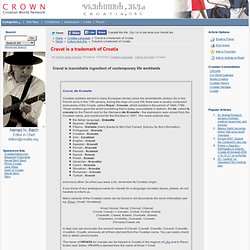
Cravat - Necktie Made in Croatia! There is no color, pattern or shape that popular psychology will not associate with a certain character trait.

According to some psychologic research, in their stripes, colours, squares and dots cravats hide habits, vices and whims of their owners. If one is interested in making witty remarks when passing someone in the street, here is a list of necktie colours and patterns that will tell one what is happening behind the official facade. Blue cravat - blue is the colour of eternity; it symbolises wholeness, peace, and a person wearing a blue tie is probably honest, quiet and calm. Red cravat - Beware! Red is ambiguous! Black cravat - A traditional tie is usually worn to funerals, but if combined with some contrasting colours and patterns, it can mean elegance and moderation. Yellow cravat - Young, hopeful, happy! Green cravat - Besides having an ecological meaning, psychologists find a green tie fairy-tale like; it expresses the wisdom of wood nymphs. Cravat. History[edit] Croatian soldier with a cravat, 17th century.

Pakrac clash. The Pakrac clash (known in Croatian as Bitka za Pakrac ("Battle of Pakrac")) was a bloodless skirmish that took place in the Croatian town of Pakrac in March 1991.
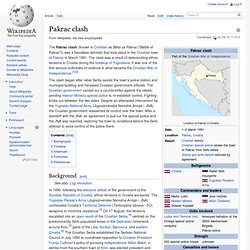
The clash was a result of deteriorating ethnic tensions in Croatia during the breakup of Yugoslavia. It was one of the first serious outbreaks of violence in what became the Croatian War of Independence.[1][2] Background[edit] On 22 February, the municipal council controlled by Džakula voted to join the Serbian Autonomous Oblast of Krajina (later renamed the RSK) and subordinate the Pakrac police station to the Ministry of Internal Affairs of Krajina.[12] The vote was annulled by the Constitutional Court of Croatia on 28 February.[13] Timeline[edit] Croatian special police at the Pakrac police station, 2 March 1991.
Operation Flash. Operation Flash (Croatian: Operacija Bljesak, Serbian: Operacija Blesak, Serbian Cyrillic: Операција Блесак) was a brief Croatian Army (HV) offensive conducted against forces of the self-declared Republic of Serbian Krajina (RSK) from 1–3 May 1995.
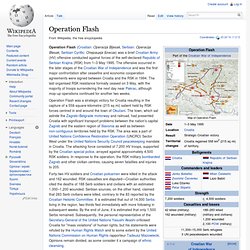
Operation Storm. Battle of Vukovar. Vukovar was defended by around 1,800 lightly armed soldiers of the Croatian National Guard (ZNG) and civilian volunteers, against 36,000 JNA soldiers and Serbian paramilitaries equipped with heavy armour and artillery.
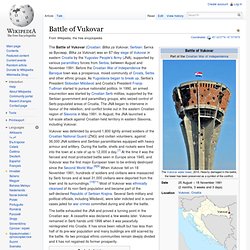
During the battle, shells and rockets were fired into the town at a rate of up to 12,000 a day.[7] At the time it was the fiercest and most protracted battle seen in Europe since 1945, and Vukovar was the first major European town to be entirely destroyed since the Second World War.[8][9] When Vukovar fell on 18 November 1991, hundreds of soldiers and civilians were massacred by Serb forces and at least 31,000 civilians were deported from the town and its surroundings.[10][11] Most of Vukovar was ethnically cleansed of its non-Serb population and became part of the self-declared Republic of Serbian Krajina.
Several Serb military and political officials, including Milošević, were later indicted and in some cases jailed for war crimes committed during and after the battle. Plitvice Lakes incident. The Plitvice Lakes incident (Croatian: Krvavi Uskrs na Plitvicama or Plitvički krvavi Uskrs, both translating as "Plitvice Bloody Easter") was an armed clash at the beginning of the Croatian War of Independence.
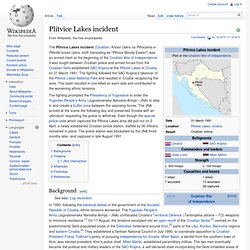
It was fought between Croatian police and armed forces from the Croatian Serb-established SAO Krajina at the Plitvice Lakes in Croatia, on 31 March 1991. The fighting followed the SAO Krajina's takeover of the Plitvice Lakes National Park and resulted in Croatia recapturing the area. The clash resulted in one killed on each side and contributed to the worsening ethnic tensions. The fighting prompted the Presidency of Yugoslavia to order the Yugoslav People's Army (Jugoslovenska Narodna Armija – JNA) to step in and create a buffer zone between the opposing forces. The JNA arrived at the scene the following day and presented Croatia with an ultimatum requesting the police to withdraw.
Background[edit] Timeline[edit] JNA intervention[edit] Croatian War of Independence. History of Croatia.